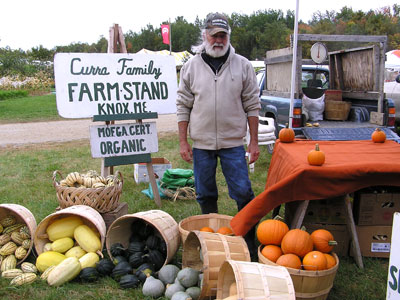 |
| Peter Curra at the Common Ground Country Fair Farmers’ Market. English photo |
Celebrating Five Decades of Farming
By Holli Cederholm
Peter and Susan Curra are not from Maine, although they have been farming here long enough that no one thinks otherwise. The farm and family history is rooted in Massachusetts soil, where they met, married, had their first of three children and started building a dairy herd.
The Curras brought their Holsteins, raised from 24 calves purchased in 1963, onto leased farmland in North Hatfield, Massachusetts, in 1966, and started selling milk to HB Hood that December.
They stayed on the leased land until May of 1970, when they moved, farm business and all, to Maine. Peter attributes their decision to move to the financial success they were experiencing on the leased farm and to how they were, in effect, paying someone else’s mortgage. It was time for them to finance their own farm.
Moving north was an easy decision for Peter. His mother’s family migrated from Lyman, Maine, to Massachusetts in 1920, and he spent parts of his childhood on a cousin’s farm in Lyman.
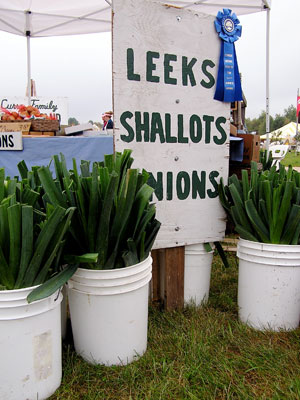 |
| Prize-winning leeks from the Curra Family Farm. English photo |
“I came back to Maine… I must have some sort of genetic attraction,” says Peter.
Building the Family Farm
The Curras found the farmland where they now reside, and where they raised their children, with help from the Farmers’ Home Administration (FHA), then located in Belfast, Maine. A Monroe farm advertised for sale in a newspaper first drew them to Waldo County. On that farm, however, “the only thing in place was the silo,” says Peter.
The FHA organized visits to six farms for sale in Waldo County, including properties in Unity and the land they eventually purchased in Knox. The latter spanned 165 acres – 60 acres in field, the remaining in woodlands – and included a new dairy barn and a house in relatively good shape.
“I said the only way I’ll ever agree to this is if my father finds that the house can be made livable,” says Susan.
Upon inspection, Susan’s father found the house’s ridgepole as straight as a rod and declared the structure to be sound. That settled, they offered the current owners $27,000 and sealed the deal with a $1 down payment and a firm handshake.
The Curras moved from Massachusetts in five stages – starting with farm machinery and ending with their cows – beginning in May of 1970. They developed the farm infrastructure bit by bit, building hay storage their second year and remodeling one room in the house each year. In 1971 they covered all their fields with poultry manure to set the foundation for good pasture and hay fields. In 1972 they cleared 7 more acres for forage crop production, picking stones by hand.
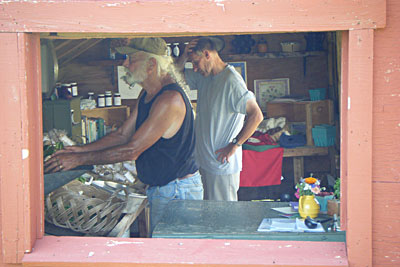 |
| Peter Curra weighs peas for a customer at the Curra Family Farm Stand. Photo by Holli Cedarholm. |
All the while, the Curras were improving their dairy herd. They switched to registered cattle and switched the herd’s diet from corn silage to mostly grass.
“The reason we went to all grass was because of the lay of the land… the pitch of it,” says Peter. “For us to raise corn on this place, we would encounter erosion problems beyond belief. We never did want to go in that direction.”
Before purchasing the land, the Curras heard from local farmers that “that farm cuts a lot of hay.” Peter and Susan invested in haying equipment and decided they didn’t want to invest in the equipment for corn too.
“The whole basis of this operation goes back to the soil… we are very fortunate that we have great soil,” says Peter. “It is not uncommon for us to have three cuts [of hay] a season.”
From Dairy to Vegetables
Of their three children, the Curras’ oldest daughter, Amy, showed the most interest in dairy farming. When she graduated from high school and went on to attend culinary school at Johnson and Wales, Peter and Susan started to reassess their farm business. “We didn’t want to work this hard if we weren’t going to do it for the next generation,” says Peter.
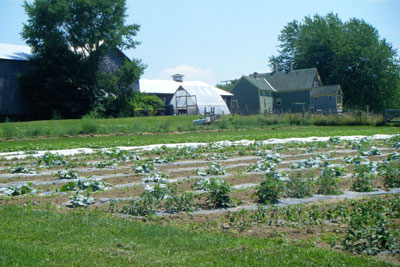 |
| A view from the fields: the Curras’ farmhouse, barns, greenhouse and vegetables. Photo by Holli Cedarholm. |
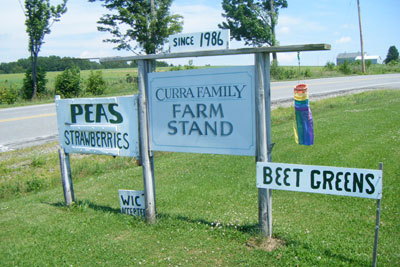 |
| The Curra Family Farm Stand is located on Route 137 in Knox, Maine. Photo by Holli Cedarholm. |
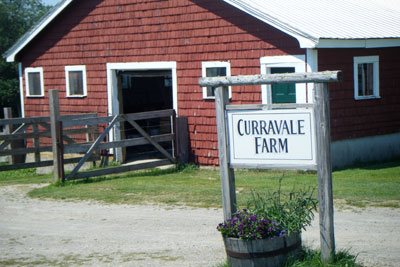 |
| Curravale Farm’s original dairy barn. Photo by Holli Cedarholm. |
Their son Seth’s scout master, a commercial potato grower, confided in Peter that he felt they were missing out on a business opportunity right at the end of their road: a farm stand. Recognizing the prospect, in 1986 the Curras started building a stand on a parcel of their land abutting Route 137 in Knox – and consequently transitioned from dairy farming to cultivating mixed vegetables.
“It started off very slowly, and increased gradually,” says Peter.
They began leasing their herd to area farmers in 1986 – starting with a dairy farmer in Brooks who lost his dairy barn to a fire and wanted to rebuild his operation. To this day, they still lease their herd to area farmers; over 20 years, 15 farmers have managed the herd.
“For me, to sell my cows would be like me selling one of my kids. You do something for 20 years or more, that’s just not an easy thing to do,” says Peter.
They built their farm stand, a red building the size of a small shed, from scrap materials, including doors and roofing salvaged from old chicken housing. They further shaved expenses by trading the loam for gravel to make the driveway.
Peter and Susan were planting their first season’s crops while they were constructing the stand. “We ran out of some stuff, and some stuff we had way too much of,” Peter recalls. They fine-tuned their future crop plans based on what grew well and sold, and sought to diversify their product line.
The Curras began stocking select items, such as maple syrup, dry beans, strawberries and sweet corn, from other local producers, as well as handmade crafts from local artisans.
Peter says, “It came early on that I need to raise the things that I and this soil have a knack to raise.”
Susan’s preserves were trademark features from the start. Each year she cans more than 900 jars of jams, jellies, relishes and chutneys in their farm kitchen. Before hiring outside help, she processed the value-added foods during the evening after tending the stand during the day.
“I had always made the jams and things as gifts for family and for our food supply,” says Susan. “Over the years, they sort of took off.”
Over the years, their business began to flourish as well. Peter recognized they were producing more vegetables than they could sell at the stand and scouted out additional markets, which, over time, came to include the Belfast Co-op (1993), Unity Farmers’ Market (1999), Common Ground Country Fair Farmers’ Market (2002) and the Senior Farm Share program.
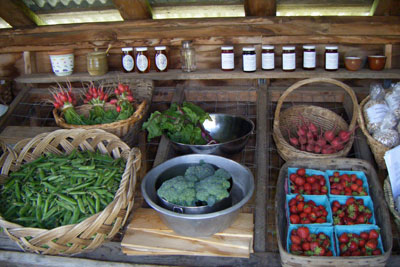 |
| Early summer vegetables displayed, along with Susan Curra’s homemade preserves, at the Curra Family Farm Stand. Photo by Holli Cedarholm. |
Peter attributes the success of their business, in part, to diversification – they added grass-fed beef to the farm along with the vegetables.
“We went from an operation that was single-commodity to a diversified-commodity operation. That is the most profound thing that has happened here,” he says.
He attributes the success at the stand wholly to his wife’s presence and conversation, and to her personal touches, such as her homemade jam and how she decorates the stand’s interior. “When she wasn’t at the stand, the regular customers always asked [for her],” says Peter.
Finding a Niche
Selling to the Belfast Co-op introduced the Curras to vegetables they would not have considered otherwise. When Peter first approached the produce manager there, he was told the Co-op did not need additional suppliers. Peter asked if he could bring anything that other local farmers weren’t growing. The answer: leeks.
“I didn’t even know what they were… So we got into the leek business, slowly but surely.”
Another request led to shallots, followed by winter squash and kale. The Curras now specialize in leeks, shallots and onions, sold mostly at the Co-op and the Common Ground Country Fair.
The same Co-op manager who prompted the Curras’ niche selection also encouraged them to grow organically. As new vegetable growers, Peter and Susan were not organic, but the Co-op manager was moving toward sourcing solely organic produce – so the Curras switched.
“To be perfectly honest, the number one impetus was financial,” says Peter, “but it grew into a more philosophical type feeling … It is something we take pride in.”
Working with the Seasons
Like most farmers, the Curras work consistently from the start of the growing season in early spring until it winds down in late fall. Peter starts early each day. The farm stand is open Wednesday through Saturday and requires ongoing harvests throughout the week. Peter and hired help (usually students from Unity College) harvest twice a week for deliveries to the Belfast Co-op and for the Unity Farmers’ Market on Saturdays. Susan splits her time between the stand and food processing.
Peter and Susan spend the off-season volunteering. “We spend six and half months doing stuff almost nonstop, then… we don’t have a job to go to, or something to do,” says Peter. So each fall they leave the farm in the hands of their son Seth and head to Florida, where Susan’s mother lives, for the winter. Susan has been a hospice volunteer for more than 20 years in Maine, and she continues to do so in Florida. Peter donates his time to the Good Samaritan Food Bank and ECHO (Educational Concerns for Hunger Organization). The ECHO farm mimics five climates in which volunteers and 10 annual interns raise seeds – from pigeon peas and hibiscus to starfruit and moringa – to ship all over the world; Peter cleans and sometimes packages the seeds.
“When you’re farming, it’s basically a hell of a lot of work,” says Peter. “Going there [Florida] helps us develop a deeper appreciation of what we have here. Leaving the farm each winter is like driving 70 miles per hour down the road and taking the key out of the ignition. Wham. It just hits you. Sue and I just love this place.”

